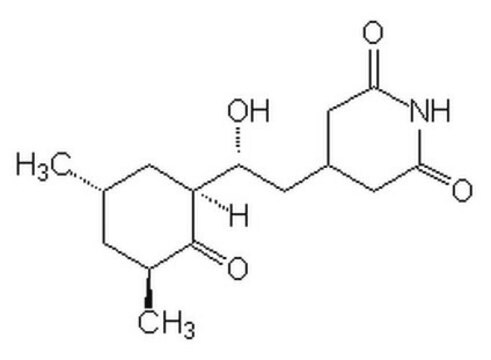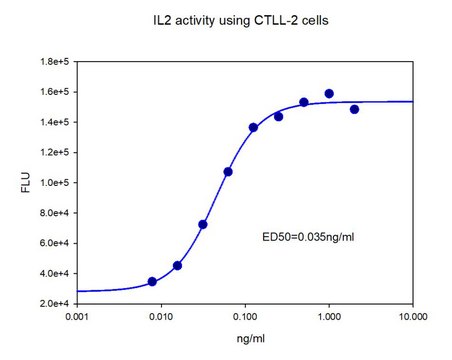SBR00013
Actinomycin D, Ready Made Solution
from Streptomyces sp., 2 mg/mL in DMSO
Synonyme(s) :
Actinomycin D solution from Streptomyces sp., Actinomycin IV, Dactinomycin
About This Item
Produits recommandés
Source biologique
Streptomyces sp.
Niveau de qualité
Description
Ready Made Solution
Forme
liquid
Conditions de stockage
protect from light
Concentration
2 mg/mL in DMSO
Couleur
dark orange
Spectre d'activité de l'antibiotique
neoplastics
Mode d’action
DNA synthesis | interferes
Température de stockage
−20°C
Chaîne SMILES
N21C(CCC2)C(=O)N(CC(=O)N(C(C(=O)OC(C(C(=O)NC(C1=O)C(C)C)NC(=O)c3c4nc5c(c([c](c(c5[o]c4c(cc3)C)C)=O)N)C(=O)NC6C(OC(=O)C(N(C(=O)CN(C(=O)C7N(CCC7)C(=O)C(NC6=O)C(C)C)C)C)C(C)C)C)C)C(C)C)C)C
InChI
1S/C62H86N12O16/c1-27(2)42-59(84)73-23-17-19-36(73)57(82)69(13)25-38(75)71(15)48(29(5)6)61(86)88-33(11)44(55(80)65-42)67-53(78)35-22-21-31(9)51-46(35)64-47-40(41(63)50(77)32(10)52(47)90-51)54(79)68-45-34(12)89-62(87)49(30(7)8)72(16)39(76)26-70(14)58(83)37-20-18-24-74(37)60(85)43(28(3)4)66-56(45)81/h21-22,27-30,33-34,36-37,42-45,48-49H,17-20,23-26,63H2,1-16H3,(H,65,80)(H,66,81)(H,67,78)(H,68,79)
Clé InChI
RJURFGZVJUQBHK-UHFFFAOYSA-N
Vous recherchez des produits similaires ? Visite Guide de comparaison des produits
Catégories apparentées
Application
<li><strong>Regulation of Immune Checkpoints in Cancer:</strong> Actinomycin D is pivotal in studying the ADAR-mediated RNA editing processes that regulate PVR immune checkpoints in colorectal cancer, thus demonstrating its crucial role in cancer immunotherapy research and providing insights into novel therapeutic targets (Qian et al., 2024).</li>
<li><strong>Chemotherapy and Immunotherapy Combination:</strong> The use of Actinomycin D in combined chemotherapy highlights its effectiveness in salvaging multi-chemotherapy agent and avelumab resistant choriocarcinoma, showcasing its potential in overcoming resistance to treatment in gynecological cancers (Lehmann et al., 2023).</li>
<li><strong>Advancements in Dental Medicine:</strong> Actinomycin D is used in regulating gene expression crucial for tissue regeneration and repair in dental health and it is also used to determine RNA stability assay (Pan et al., 2023).</li>
<li><strong>Cancer Progression Research:</strong> The study on hypoxia-induced lncRNA in hepatocellular carcinoma progression, where RNA-binding proteins play a critical role, aligns with Actinomycin D′s application in transcriptional inhibition and its influence on mRNA stability, essential for understanding cancer biology and developing targeted therapies (Tuo et al., 2023).</li>
</ul>
Actions biochimiques/physiologiques
Actinomycin D has been shown to be an inhibitor of the minus-strand transfer step in reverse transcription, and is therefore used in studies and suppression of HIV-replication. It has also been shown to suppress programmed cell death of PC12 cells induced by etoposide, an inhibitor of topoisomerase II.
In cell culture, actinomycin D is used as a selection agent. Actinomycin D binding to yeast in ribosomal RNA has been studied. The sensitivity of various strains of E. coli to actinomycin D and the mechanism of binding has been studied. Actinomycin D is also used in molecular biology as a DNA intercalator which blocks the progression of RNA polymerases.
Conditionnement
Attention
Notes préparatoires
Mention d'avertissement
Danger
Mentions de danger
Conseils de prudence
Classification des risques
Carc. 1B
Code de la classe de stockage
6.1C - Combustible acute toxic Cat.3 / toxic compounds or compounds which causing chronic effects
Classe de danger pour l'eau (WGK)
WGK 3
Point d'éclair (°F)
188.6 °F - closed cup
Point d'éclair (°C)
87 °C - closed cup
Faites votre choix parmi les versions les plus récentes :
Déjà en possession de ce produit ?
Retrouvez la documentation relative aux produits que vous avez récemment achetés dans la Bibliothèque de documents.
Les clients ont également consulté
Global Trade Item Number
| Référence | GTIN |
|---|---|
| SBR00013-1ML | 4061838094407 |
Notre équipe de scientifiques dispose d'une expérience dans tous les secteurs de la recherche, notamment en sciences de la vie, science des matériaux, synthèse chimique, chromatographie, analyse et dans de nombreux autres domaines..
Contacter notre Service technique








